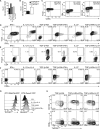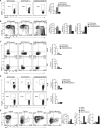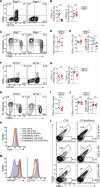Transcription factor T-bet regulates intraepithelial lymphocyte functional maturation
- PMID: 25148025
- PMCID: PMC4287410
- DOI: 10.1016/j.immuni.2014.06.017
Transcription factor T-bet regulates intraepithelial lymphocyte functional maturation
Abstract
The intestinal epithelium harbors large populations of activated and memory lymphocytes, yet these cells do not cause tissue damage in the steady state. We investigated how intestinal T cell effector differentiation is regulated upon migration to the intestinal epithelium. Using gene loss- and gain-of-function strategies, as well as reporter approaches, we showed that cooperation between the transcription factors T-bet and Runx3 resulted in suppression of conventional CD4(+) T helper functions and induction of an intraepithelial lymphocyte (IEL) program that included expression of IEL markers such as CD8αα homodimers. Interferon-γ sensing and T-bet expression by CD4(+) T cells were both required for this program, which was distinct from conventional T helper differentiation but shared by other IEL populations, including TCRαβ(+)CD8αα(+) IELs. We conclude that the gut environment provides cues for IEL maturation through the interplay between T-bet and Runx3, allowing tissue-specific adaptation of mature T lymphocytes.
Copyright © 2014 Elsevier Inc. All rights reserved.
Figures






Comment in
-
T-bet orchestrates CD8αα IEL differentiation.Immunity. 2014 Aug 21;41(2):169-71. doi: 10.1016/j.immuni.2014.08.003. Immunity. 2014. PMID: 25148017 Free PMC article.
Similar articles
-
The transcription factor T-bet is induced by IL-15 and thymic agonist selection and controls CD8αα(+) intraepithelial lymphocyte development.Immunity. 2014 Aug 21;41(2):230-43. doi: 10.1016/j.immuni.2014.06.018. Immunity. 2014. PMID: 25148024
-
Virus-induced activation of self-specific TCR alpha beta CD8 alpha alpha intraepithelial lymphocytes does not abolish their self-tolerance in the intestine.J Immunol. 2004 Apr 1;172(7):4176-83. doi: 10.4049/jimmunol.172.7.4176. J Immunol. 2004. PMID: 15034030
-
T-bet orchestrates CD8αα IEL differentiation.Immunity. 2014 Aug 21;41(2):169-71. doi: 10.1016/j.immuni.2014.08.003. Immunity. 2014. PMID: 25148017 Free PMC article.
-
Lineage re-commitment of CD4CD8αα intraepithelial lymphocytes in the gut.BMB Rep. 2016 Jan;49(1):11-7. doi: 10.5483/BMBRep.2016.49.1.242. BMB Rep. 2016. PMID: 26592937 Free PMC article. Review.
-
CD8αα TCRαβ Intraepithelial Lymphocytes in the Mouse Gut.Dig Dis Sci. 2016 Jun;61(6):1451-60. doi: 10.1007/s10620-015-4016-y. Epub 2016 Jan 14. Dig Dis Sci. 2016. PMID: 26769056 Review.
Cited by
-
Regulation of effector and memory CD8 + T cell differentiation: a focus on orphan nuclear receptor NR4A family, transcription factor, and metabolism.Immunol Res. 2023 Jun;71(3):314-327. doi: 10.1007/s12026-022-09353-1. Epub 2022 Dec 26. Immunol Res. 2023. PMID: 36571657 Review.
-
Characterization of Bovine Intraepithelial T Lymphocytes in the Gut.Pathogens. 2023 Sep 19;12(9):1173. doi: 10.3390/pathogens12091173. Pathogens. 2023. PMID: 37764981 Free PMC article.
-
Downregulation of chemokine receptor 9 facilitates CD4+CD8αα+ intraepithelial lymphocyte development.Nat Commun. 2023 Aug 24;14(1):5152. doi: 10.1038/s41467-023-40950-2. Nat Commun. 2023. PMID: 37620389 Free PMC article.
-
The Roles of RUNX Proteins in Lymphocyte Function and Anti-Tumor Immunity.Cells. 2022 Oct 3;11(19):3116. doi: 10.3390/cells11193116. Cells. 2022. PMID: 36231078 Free PMC article. Review.
-
Normalizing Microbiota-Induced Retinoic Acid Deficiency Stimulates Protective CD8(+) T Cell-Mediated Immunity in Colorectal Cancer.Immunity. 2016 Sep 20;45(3):641-655. doi: 10.1016/j.immuni.2016.08.008. Epub 2016 Aug 30. Immunity. 2016. PMID: 27590114 Free PMC article.
References
-
- Cheroutre H, Lambolez F. Doubting the TCR coreceptor function of CD8alphaalpha. Immunity. 2008;28:149–159. - PubMed
-
- Denning TL, Granger SW, Mucida D, Graddy R, Leclercq G, Zhang W, Honey K, Rasmussen JP, Cheroutre H, Rudensky AY, Kronenberg M. Mouse TCRalphabeta+CD8alphaalpha intraepithelial lymphocytes express genes that down-regulate their antigen reactivity and suppress immune responses. J. Immunol. 2007;178:4230–4239. - PubMed
Publication types
MeSH terms
Substances
Grants and funding
LinkOut - more resources
Full Text Sources
Other Literature Sources
Research Materials

